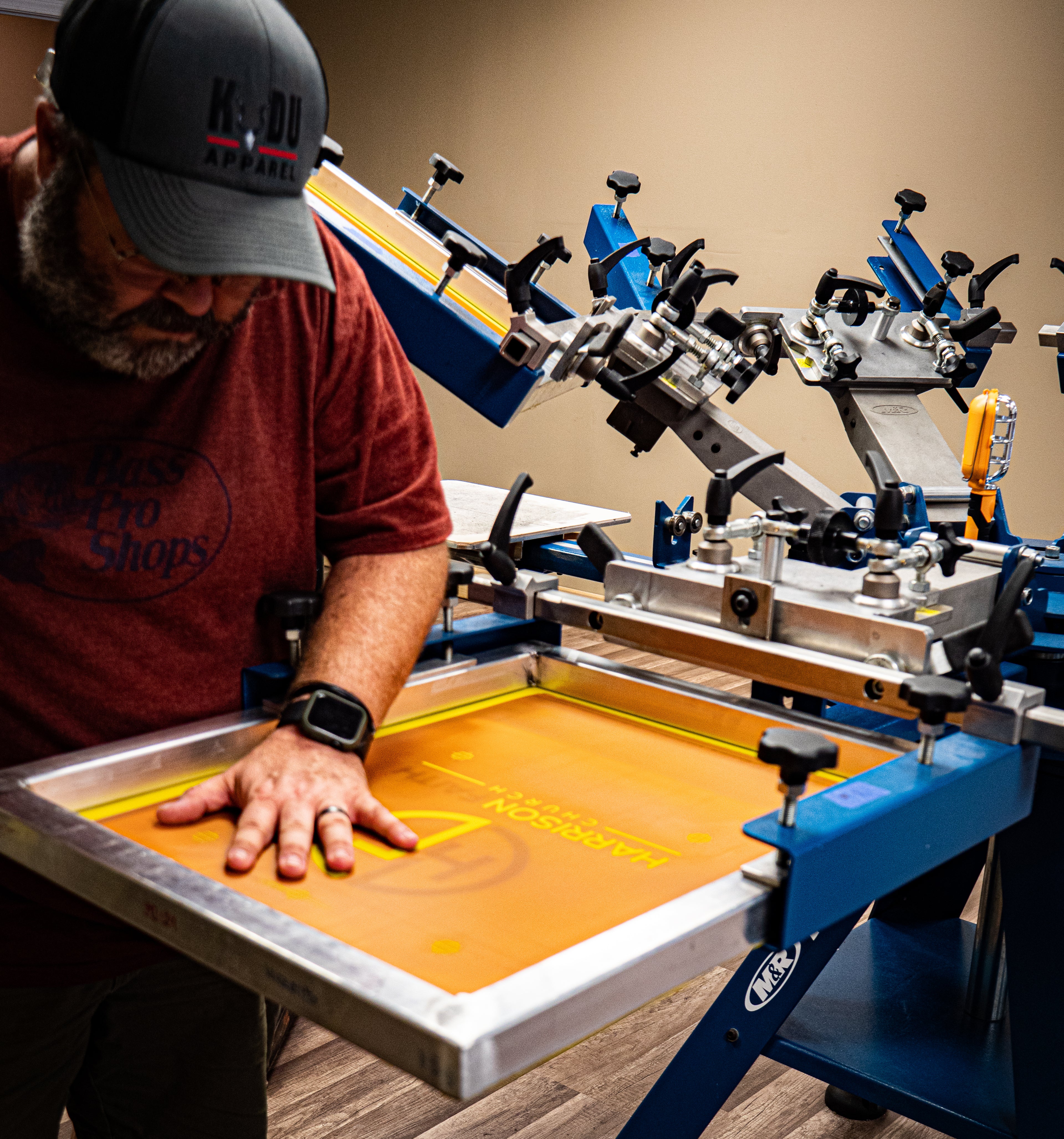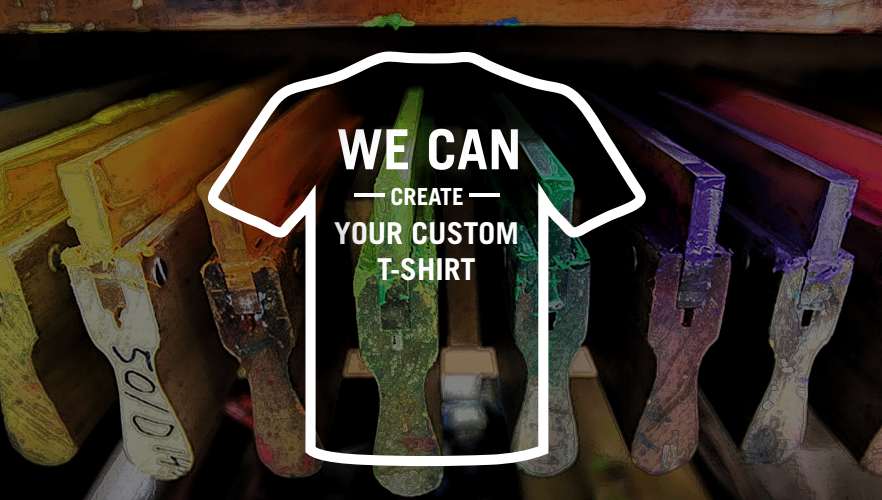High-End Silk Screen Printing for Premium Garments
High-End Silk Screen Printing for Premium Garments
Blog Article
Display Printing Uncovered: Whatever You Required to Learn About Tee and Garment Printing Strategies
Screen printing is a remarkable method that combines art with technique, using countless possibilities for creativity. Prepared to discover the essential elements that make screen printing an art type?
The Essentials of Display Printing: How It Works
When you dive into screen printing, you'll find it's both an art and a scientific research. At its core, screen printing involves creating a stencil, or display, that enables ink to go through only in details areas (screen printing kit). You begin by selecting your style and preparing your screen with a light-sensitive emulsion. As soon as you subject this solution to light, it hardens, leaving your design as a negative area.
Next, you'll blend your inks and prepare your printing surface. Placement the display over the textile, after that make use of a squeegee to push ink via the display onto the garment. This process calls for accuracy, as you want clear, vivid prints. After printing, you'll treat the ink with warm, guaranteeing it sticks to the textile and lasts via washes. Each step is essential, and grasping them will certainly elevate your screen printing skills, transforming easy garments into distinct, meaningful pieces.
Sorts Of Screen Printing Strategies
As soon as you comprehend the basics of display printing, it's time to explore the different methods that can raise your styles. One prominent technique is typical display printing, where ink is pressed through a stenciled screen. This technique is excellent for strong, vibrant colors. After that there's water-based ink printing, which offers a softer feel and is eco-friendly, but it calls for a different method to treating.
An additional alternative is plastisol printing, understood for its sturdiness and brilliant colors, making it a preferred for numerous brands. Experiment with halftone printing to develop gradient impacts and intricate designs.
Vital Devices for Screen Printing
To attain magnificent results in display printing, having the ideal devices is basic. You'll need a strong display printing frame, which holds the mesh that moves your layout onto the garment. Next, invest in top quality mops; these are important for using ink equally throughout the display.
Selecting the Right Inks and Products
When choosing inks and products for screen printing, you need to think about the kind of ink that works finest for your task. Consider fabric compatibility to assure your layouts look fantastic and last lengthy. Check out green ink choices to make your printing process a lot more sustainable.
Sorts Of Screen Inks
Selecting the right screen ink is crucial for attaining dynamic, long lasting prints that fulfill your project's needs. There are numerous kinds of screen inks to check out. Plastisol ink is prominent for its flexibility and convenience of use, offering excellent color opacity on dark textiles. Water-based ink, on the other hand, offers a softer feeling and is environmentally friendly, making it ideal for those looking to reduce their environmental effect. Release inks get rid of color from the fabric, causing a soft, vintage look yet call for details handling. Specialty inks, such as metallic or glow-in-the-dark, can add special effects to your designs. Evaluate your job requirements and select the ink that aligns finest with your wanted result.

Fabric Compatibility Considerations
Comprehending textile compatibility is important for achieving top quality display prints, especially since different materials respond distinctively to numerous inks. Constantly examine your inks on example fabric to assure they adhere effectively and preserve shade stability. In addition, keep in mind that textile weight and structure can influence the last end result, so picking the appropriate ink and product combo is vital for your task's success.
Eco-Friendly Ink Options
Environment-friendly inks are becoming a popular option for display printers who desire to reduce their ecological impact while maintaining top quality. When choosing inks, think about water-based inks, which are less dangerous and simpler to cleanse up compared to traditional solvents.
In addition, look for inks made from sustainable resources, such as soy or vegetable-based alternatives. By choosing the appropriate inks and materials, you'll not just create sensational styles however also contribute to an extra lasting printing process. Make the switch, and your prints will mirror your commitment to the atmosphere!
Preparing Your Design for Screen Printing

File Style Demands
To ensure your style looks sharp and vibrant on fabric, you'll need to pay close focus to submit style requirements for screen printing. Beginning with vector data like AI or EPS, as they can be scaled without losing high quality. If you utilize raster photos, choose for high-resolution documents, such as TIFF or PNG, ideally at 300 DPI. Avoid utilizing JPEGs, as they can shed quality when resized. Likewise, see to it your style has a transparent history to stop unwanted white sides on your prints. Maintain color settings in mind; CMYK is common for display printing, so transform your RGB designs as necessary - screen printing kit. By adhering to these guidelines, you'll establish your artwork up for an effective print.
Shade Splitting Up Strategies
Shade separation is a crucial step in preparing weblink your layout for screen printing, and grasping it can considerably enhance your print top quality. You'll require to damage your style into private shades, as each shade needs a different display during printing. This accuracy not only guarantees accurate shade depiction however additionally enhances the printing process.
Resolution and Size
Attaining the very best cause display printing starts with ensuring your layout has the best resolution and dimension. Ideally, visite site your artwork should go to the very least 300 DPI (dots per inch) for sharp, clear prints. If you utilize lower resolution, your end product might look pixelated and amateur.
When it concerns size, take into consideration the dimensions of your print area. Layout your art work to match the last print dimension, ideally developing it in the actual dimensions you'll be publishing. By doing this, you'll avoid any unanticipated scaling concerns.
Always inspect your layout in both vector and raster formats. Vector graphics can be scaled without losing quality, making them ideal for screen printing. Preparing appropriately will guarantee your design looks incredible on every garment!
Step-by-Step Display Printing Process
Display printing is a vibrant procedure that permits you to produce vibrant designs on different surface areas. To begin, you'll require a display, emulsion, and your chosen ink. Prepare your display by cleaning it extensively. Next, use the emulsion evenly and allow it dry in a dark location. As soon as completely dry, reveal your display to light with your layout put on it, which will certainly set the emulsion where the light hits, developing a stencil - screen printing kit.
Put ink onto the display and use a squeegee to push the ink via the stencil onto the material. Raise the screen thoroughly and allow the print dry. You have actually effectively screen published your design.
Tips for Successful Display Printing Projects
While you're diving right into your screen printing projects, keep in mind that prep work is vital to success. Beginning by collecting all your materials-- inks, garments, displays, and mops. A tidy workspace assists protect against undesirable mistakes, so clean up before you start.
Following, validate your art work is high-resolution and appropriately sized for your garment. Test your display for proper direct exposure and tidy it extensively to avoid smudges. When mixing your inks, adhere to the manufacturer's standards to accomplish the best consistency.
Throughout printing, apply also stress with your squeegee for regular results. Don't hurry; take your time to verify each print meets your criteria. After printing, allow your garments dry entirely before dealing with or packaging them.
Lastly, constantly maintain an example of your job for future referral. In this manner, you can analyze your progress and improve your strategies in time. Pleased printing!

Regularly Asked Concerns
How much time Does It Take to Establish a Display Printing Job?
Establishing a display printing task article source generally takes around thirty minutes to an hour. You'll prepare the displays, mix inks, and change the press. The moment differs based upon intricacy and experience, so stay arranged!
Can I Print on Different Material Types Utilizing the Very Same Method?
Yes, you can print on various fabric types using the same method, but you'll need to readjust your setups and inks. Some textiles absorb ink differently, so trying out warranties the most effective outcomes for each and every material.
What Prevail Mistakes to Avoid in Display Printing?
When display printing, prevent typical mistakes like making use of the wrong ink, disregarding correct direct exposure times, or skipping pre-press checks. Always check your configuration and preserve tidy screens to guarantee high quality results each time.
How Can I Effectively Tidy and Maintain My Screen Printing Equipment?
To effectively clean and preserve your display printing devices, you need to consistently wash screens with proper solvents, check squeegees for wear, and ensure all devices are kept dust-free and dry. Consistency boosts and stops expensive fixings efficiency.
Is Screen Printing Environmentally Pleasant Compared to Other Techniques?
Display printing can be a lot more environmentally pleasant than various other approaches, especially if you use water-based inks and eco-conscious products. By choosing sustainable supplies and techniques, you reduce waste and decrease your effect on the world.
Screen Printing Uncovered: Whatever You Need to Know About Tee and Garment Printing Techniques
At its core, screen printing includes producing a stencil, or display, that enables ink to pass through just in particular areas. Placement the display over the material, then utilize a squeegee to push ink via the screen onto the garment. One prominent approach is traditional screen printing, where ink is pressed with a stenciled display.When selecting inks and products for display printing, you need to take into account the kind of ink that works ideal for your project.
Report this page